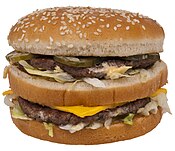Big King
During its testing phase in 1996–1997, it was originally called the Double Supreme and was configured similarly to the McDonald's Big Mac—including a three-piece roll.
The product was renamed King Supreme in 2001 when it was slightly reformulated as part of a menu restructuring during a period of corporate decline.
When the Stacker line was discontinued in the United States shortly after, the Big King returned in November 2013 as a permanent product.
[4][5] Hoping to build on improving sales of Burger King and take advantage of perceived market weakness of McDonald's, the chain introduced the Double Supreme as part of an advertising blitz against its competitor.
Originally, the burger had a look and composition that resembled the Big Mac: it had two beef patties, "King" sauce, lettuce, cheese, pickles and onions on a three-part sesame seed bun.
[6] The Double Supreme was advertised with a direct attack on the Big Mac, using the claims that it had 75% more beef and less bread than the McDonald's sandwich.
[10][14] The McDonald's drop capped a three-year decline in the larger chain's market share in the United States, which stood at 42.3% at the start of 1995.
Corporate indifference from parent Diageo coupled with lagging sales at larger franchises caused by declining consumer demand for its products led the company to initiate a menu redesign to try to lure customers back into stores.
[6][17] Burger King changed ownership in 2002 when Diageo sold its interest in the company to a group of investment firms led by TPG Capital.
After assuming ownership, TPG's newly appointed management team began focusing menu development and advertising on a very narrow demographic group, young men aged 20–34 who routinely ate at fast food restaurants several times per month which the chain identified as the "super fan".
The Stacker line was part of a series of larger, more calorie-laden products introduced by the company to entice the super-fan into the chain's restaurants.
The cheeseburger deluxe consisted of lettuce, pickles, onions, American cheese and Stacker sauce in a combinations similar to the King Supreme.
[29] The sandwiches were a part of the new ownership's plans to expand its customer base beyond the 18- to 34-year-old demographic which it had been targeting over the previous several years.
After 3G purchased Burger King, its new management team refocused on a broader menu strategy to lure a more diverse customer base.
The limited-time offers allow chains to bring "new" products to the menu without adding permanent complexity to their kitchen operations.
This includes the Big Shef sandwich originally from now-defunct chain Burger Chef and occasionally produced as a LTO from current trademark owner Hardee's.
[43][44][45][46] The Big N' Tasty eventually won out in testing, however its national roll-out was delayed due to a corporate reorganization at McDonald's.
This new variation on the original Big King sandwich was part of a corporate menu restructuring that began the previous year.
This was part of Burger King CEO Alex Macedo's plan to introduce simpler products that require few or no new ingredients in order to simplify operations.
This new sandwich uses the company's existing Crispy Chicken Jr patty in place of the beef and adds an extra layer of King sauce to ensure that the product stays moist.
It debuted with a slightly altered recipe that included an extra layer of lettuce and shifted the pickles to the bottom half of the burger.
The close similarities in the name, appearance and the marketing of the burger led to McDonald's suing Hungry Jack's in the Federal Court of Australia in August 2020 over trademark infringement.
[55] The Big Jack and all its variants had been previously removed from the menu in late 2021, though it later returned as a limited time item after the suit was resolved.
[54] The Double Supreme was promoted in a series of advertisements created by the New York firm of Ammirati Puris Lintas (APL).
"[60] The King Supreme debuted with an advertising campaign created by the McCaffery Ratner Gottlieb & Lane agency and commercials produced by Aspect Ratio which featured blues legend B.B.
[61][62] The advertisements featured 15- and 30-second television spots in which King is shown sitting on a crescent moon, playing his guitar Lucille while speaking about the products and singing the company's slogan.
[68] The company's online advertising program in Spain described the BK XXL line as being made "with two enormous portions of flame-broiled meat that will give you all the energy you need to take the world by storm."
This claim combined with the television advertising were the prime motivators behind the Spanish government's concerns with the XXL sandwich line.





